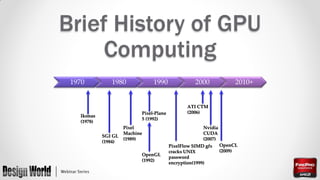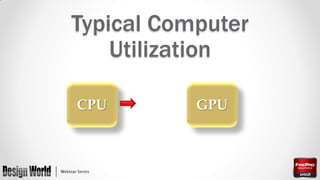OpenCL & the Future of Desktop High Performance Computing in CAD
- 1. OpenCL™ & the Future of Desktop High Performance Computing in CAD
- 2. Before We Start This webinar will be available afterwards at designworldonline.com & email Q&A at the end of the presentation Hashtag for this webinar: #DWwebinar
- 3. Moderator Presenter Joe Gorse Allen Bourgoyne Design World AMD
- 4. OpenCL™ & the Future of Desktop High Performance Computing in CAD Allen Bourgoyne, Director ISV Alliance Team AMD Professional Graphics
- 5. Agenda Introduction Processors everywhere History of GPU Computing What is OpenCL™ How is OpenCL™ changing CAD? • Conclusion • • • •
- 6. Introduction
- 7. Who am I? • Allen Bourgoyne o Director, ISV Alliances AMD Professional Graphics
- 8. What is OpenCL™? • Open Compute Language, OpenCL™, is the first open, royalty free standard for cross platform programming for personal computers, servers, workstations, hand-held devices, supporting a variety of CPUs, GPUs, and DSPs.
- 10. Modern Computers Have Lots of Processors • Central Processing Unit (CPU) • Graphics Processing Unit (GPU) • Others o o o o Network Controllers Device controllers (disks, DVD-ROMs, etc) Smart Batteries Most of these are not generally available for application software use
- 11. What Processors Can I Use? • CPU: traditionally runs operating system, user programs, system functions o General purpose design: run lots of things o Some parallel processing capability • CPUs have multiple processing cores (2, 4, 8, up to 12) • Can use multiple CPUs to increase parallel processing capability o Processing power & memory generally available to user programs • Low-level compute functionality generally available to programs • Programs can directly access memory, operating system can provide for “virtual memory”
- 12. What Processors Can I Use? • GPU: traditionally runs graphics programs o Highly focused design: Run graphics programs o Highly parallel processing designs • Modern GPUs can have over 1000 processing units! o Low-level compute functionality not generally available to programs (until very recently) o Processing power & memory generally available to graphics programs • Physical memory only, no virtual memory available
- 13. What Processors Can I Use? • Others: o Not generally available for application software o Can be used (not always for good!) • Recent hacks have used “smart” battery controllers to ruin batteries (over charge, not charge) and install malware5 o Historically, if there is a processor in the system that has an interface that can be exploited, it will be eventually • Focus today: CPUs & GPUs
- 14. What is HPC? • High Performance Computing Historically refers to computing that involves extremely large amounts of computer processing Examples: Simulating nuclear explosions Global weather Seismic data processing (looking for Oil & Gas) Breaking codes/ciphers Computing Pi to ridiculous numbers of decimal points!!
- 15. HPC Has Been Around for a Long Time • Original mainframe computers designed to solve complex math problems • CAD: crash simulation, structural analysis, etc • Historically done on compute servers o o o Lots of CPUs with lots of cores Jobs submitted in batches Long turn around times, some times takes days or weeks! • Desktops/laptops getting more powerful o HPC workloads showing up here!
- 16. Brief History of GPU Computing 1970 1980 1990 Pixel-Plane 5 (1992) Ikonas (1978) SGI GL (1984) Pixel Machine (1989) OpenGL (1992) 2000 2010+ ATI CTM (2006) Nvidia CUDA (2007) PixelFlow SIMD gfx cracks UNIX password encryption(1999) OpenCL (2009)
- 17. Using the GPU for Computing • Using GPUs for computing has been around for a long time! o As soon as they started showing up in computers, people started trying to use them to help speed up compute tasks • Why? o GPUs have some unique design characteristics that enable them to perform certain mathematical functions extremely fast
- 18. Computer Graphics 101 • How to draw a triangle on your computer screen: Y X A(x,y,z) Z B(x,y,z) C(x,y,z)
- 19. Computer Graphics 101 – Math to Draw that Triangle! • Project 3D points onto 2D display: o • For point (Ax, Ay, Az), projected point (Px, Py) Draw lines, fill triangle: Determine slope for each line: Slope = (Bx – Ax) / (By – Ay) Any coordinate on line: Ax Px Py = Sx 0 0 0 0 Sz Ay + Cx Cz Cx = Ax + slope * (Cy – Ay) A(x,y,z) Az Do this for vectors AB and AC, we will have the points to create lines to fill the triangle B(x,y,z) C(x,y,z)
- 20. GPU Processing Power • As you can see, it takes a bit of math processing to draw that triangle • Problem: Stuff we want to draw has lots of triangles! o Interactive rates are 30 frames per second (fps) • Example: 1 million triangle model @ 30 fps requires drawing 30 million triangles per second! o And that’s a small model! • Solution: GPUs have to be able to process lots of triangles!
- 21. GPU Processing Power • Modern GPUs can process hundreds of millions of triangles per second o That’s a lot of vector math: DOT products, matrix multiplies, etc. • High degree of parallel processing enables GPUs to handle this workload o Modern GPUs do thousands of operations in parallel in order to meet the demands that graphics applications place on the hardware
- 22. GPU Processing Power • So what does this mean? o GPUs have a lot of processing power! • CPU vs GPU computing power: • CPU: ~ 200 GFLOPS2 • GPU: > 3 TFLOPS1
- 23. So Why Should I Care if My GPU is used for Compute? • Answer: Money & Performance! • Not quite that simple, let’s take a look at how our computer generally operates…
- 25. Compute Usage • In most cases, the CPU and GPU aren’t that busy when the other guy is working: o GPU mostly idle while loading files, writing to disk, etc. o CPU can be less busy when waiting for the GPU to complete graphics tasks • These ebbs & flows of workloads create idle cycles, but also the opportunity to move compute tasks to the available resource o Try to make use of the idle time!
- 26. Compute Power • Remember the CPU vs GPU performance comparison? ALU ALU ALU CPU ALU CACHE MEMORY GPU MEMORY
- 27. How do I get my $$$s Worth? • Software developers are working on tapping into those unused compute cycles and untapped compute power of the GPU o End user software demands ever increasing: • Modern automotive models can contain up to 50,000 parts with 10 to 20 GB of data. The number of triangles can reach 40,000,000 polygons/model6 o OpenCL™ is a tool that will enable software developers to tap into the full power available on the computer!
- 28. What is OpenCL™?
- 29. OpenCL™ • Industry standard programming language for parallel computing • Specification by Khronos • Software using OpenCL runs on many enabled devices o Runs on CPUs, GPUs, ARM processors, Windows, Linux, Apple OS, Android Os’s o Supported by major hardware & software vendors including AMD, Intel, Nvidia, Apple, ARM
- 30. Who is Khronos? • Open consortium creating standards o The Khronos Group is a not for profit industry consortium creating open standards for the authoring and acceleration of parallel computing, graphics and dynamic media on a wide variety of platforms and devices o Commitment to royalty free standards o Founded almost 10 years ago, over 100 members, any company welcome to join o Standards include OpenGL®, OpenCL™, WebGL, WebVG™, OpenWF™
- 32. Developers Want Open Standards! • June 2011 developer survey shows adoption of OpenCL3
- 33. OpenCL™ & CAD • OpenCL™ is a powerful tool designed to unleash the power of processors in a platform independent way • Software developers are taking advantage of OpenCL™ to provide significant increases in both computation and graphics compute performance
- 34. OpenCL™ Based Solutions • Engineering analysis o Very high compute requirements, GPUs can help offload some of the compute workload o Solutions shipping today from Dassault Systemes, OpenCASCADE
- 35. Performance Gains with OpenCL™ % Speed-up Abaqus/Standard 6.11 Over 200% Speed-up with OpenCL™ VS. CPU only4 % speed-up with GPU & OpenCL™ 230 228 226 224 222 220 S4B Benchmark customer Data #1 Job Name Operations per Iteration Solver Speed Up Overall Speedup using CPU plus GPU & OpenCL s4B Benchmark dataset 10.3 TFLOPS 2.4X 2.3X Customer Data #1 5.75 TFLOPS 2.4X 2.2X
- 36. OpenCL™ & Design • OpenCL™ will impact the design phase as well o Ability to accelerate high-quality, photo-realistic rendering in real time • Interact with realistic models in realistic environments in real time! o Provide physically accurate rendering: lights, reflections, etc. are rendered physically where they will show up on the actual product
- 37. OpenCL™ & Design Chaos Group V-Ray render engine with GPU acceleration provides interactive rendering Image courtesy of Chaos Group OPTIS Theiea simulate reality for design review pipelines Image courtesy of OPTIS
- 38. OpenCL ™ & CAD • Just scratching the surface o OpenCL only available for less than 2 years • Already impacting analysis & design software • Migration from other software verticals o Digital Content Creation (DCC) • Realistic cloth simulations, physics, particle simulation, AI already supported
- 39. What’s Next? • Any computationally intensive task is a good candidate: o CFD, FEA, particle simulation, etc. • Most major ISVs already working with OpenCL™ o Many more software titles will implement OpenCL in 2012
- 40. Thank You
- 41. References 1. 5. http://www.amd.com/us/products/desktop/graphics/amd-radeon-hd-6000/hd-6990/Pages/amd-radeon-hd-6990overview.aspx#3 http://www.maxxpi.net/pages/result-browser/top10---flops.php Market data provided by Evans Data Corporation | June 2011 Testing conducted on a Dell T7400 w/ Intel Xeon E5405 CPU, 64GB RAM, Red Hat® OS v5.5, ATI FirePro™ V9800, AMD Catalyst Pro 10.12, Dassault Systemes SIMULIA ® Abaqus/Standard 6.11 http://www.v3.co.uk/v3-uk/news/2099616/black-hat-charlie-miller-explains-apple-battery-hack 6. http://cadspeed.wordpress.com/2011/05/18/opencl-will-rock-the-cad-world-part-1-why-you-want-it/ 2. 3. 4.
- 42. Disclaimer The information presented in this document is for informational purposes only and may contain technical inaccuracies, omissions and typographical errors. The information contained herein is subject to change and may be rendered inaccurate for many reasons, including but not limited to product and roadmap changes, component and motherboard version changes, new model and/or product releases, product differences between differing manufacturers, software changes, BIOS flashes, firmware upgrades, or the like. AMD assumes no obligation to update or otherwise correct or revise this information. However, AMD reserves the right to revise this information and to make changes from time to time to the content hereof without obligation of AMD to notify any person of such revisions or changes. AMD MAKES NO REPRESENTATIONS OR WARRANTIES WITH RESPECT TO THE CONTENTS HEREOF AND ASSUMES NO RESPONSIBILITY FOR ANY INACCURACIES, ERRORS OR OMISSIONS THAT MAY APPEAR IN THIS INFORMATION. AMD SPECIFICALLY DISCLAIMS ANY IMPLIED WARRANTIES OF MERCHANTABILITY OR FITNESS FOR ANY PARTICULAR PURPOSE. IN NO EVENT WILL AMD BE LIABLE TO ANY PERSON FOR ANY DIRECT, INDIRECT, SPECIAL OR OTHER CONSEQUENTIAL DAMAGES ARISING FROM THE USE OF ANY INFORMATION CONTAINED HEREIN, EVEN IF AMD IS EXPRESSLY ADVISED OF THE POSSIBILITY OF SUCH DAMAGES.
- 43. Questions? Design World Joe Gorse Email: [email protected] Phone: 440.234.4531 ext. 111 Twitter: @DesignWorld_EE AMD Allen Bourgoyne Email: [email protected] Phone: 512.602.4738
- 44. Thank You This webinar will be available at designworldonline.com & email Tweet with hashtag #DWwebinar Connect with Twitter: @DesignWorld Facebook.com/engineeringexchange LinkedIn: Design World Group YouTube.com/designworldvideo Discuss this on EngineeringExchange.com













































